现代英语词汇学概论3 word-formation
Wordformation英语构词法课件下载
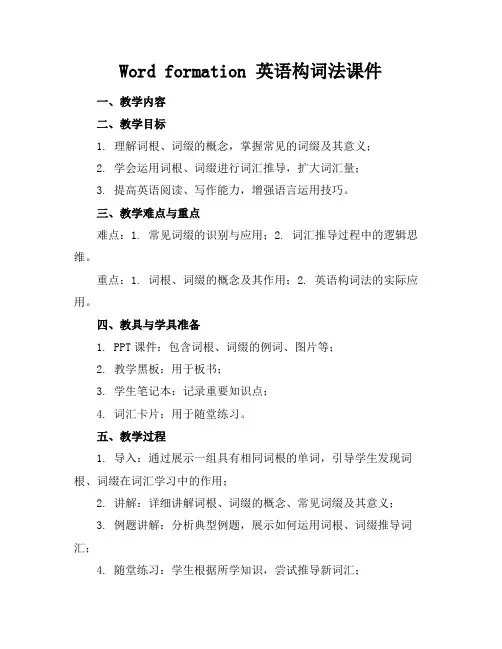
Word formation 英语构词法课件一、教学内容二、教学目标1. 理解词根、词缀的概念,掌握常见的词缀及其意义;2. 学会运用词根、词缀进行词汇推导,扩大词汇量;3. 提高英语阅读、写作能力,增强语言运用技巧。
三、教学难点与重点难点:1. 常见词缀的识别与应用;2. 词汇推导过程中的逻辑思维。
重点:1. 词根、词缀的概念及其作用;2. 英语构词法的实际应用。
四、教具与学具准备1. PPT课件:包含词根、词缀的例词、图片等;2. 教学黑板:用于板书;3. 学生笔记本:记录重要知识点;4. 词汇卡片:用于随堂练习。
五、教学过程1. 导入:通过展示一组具有相同词根的单词,引导学生发现词根、词缀在词汇学习中的作用;2. 讲解:详细讲解词根、词缀的概念、常见词缀及其意义;3. 例题讲解:分析典型例题,展示如何运用词根、词缀推导词汇;4. 随堂练习:学生根据所学知识,尝试推导新词汇;6. 作业布置:布置课后作业,巩固所学知识。
六、板书设计1. 板书Word Formation English wordbuilding methods2. 主要内容:词根、词缀的概念;常见前缀、后缀及其意义;词汇推导方法;实例展示。
七、作业设计1. 作业题目:b. 根据所学词根、词缀,推导出5个新词汇,并给出简要解释。
2. 答案:Happy → Unhappy(前缀“un”表示否定)Do → Undo(前缀“un”表示否定)Bind → Unbind(前缀“un”表示否定)Cover → Uncover(前缀“un”表示否定)八、课后反思及拓展延伸拓展延伸:引导学生关注其他语言中的构词法,如法语、德语等,了解不同语言之间的构词特点,提高跨文化交际能力。
重点和难点解析1. 教学难点与重点的识别;2. 教学过程中的例题讲解;3. 作业设计中的词汇推导;4. 课后反思及拓展延伸的实践应用。
一、教学难点与重点的识别在英语构词法的教学中,识别并明确难点和重点是至关重要的。
Unit 3英语词汇学 Word formation
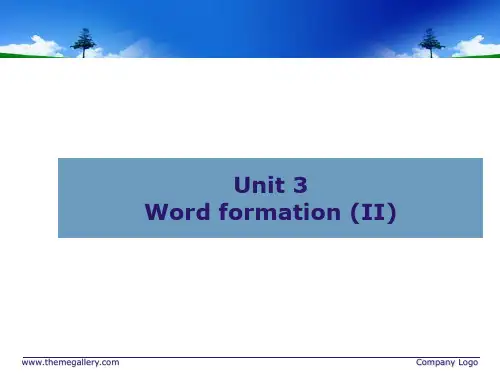
Company Logo
Exercises I. Tell meaning of the following initialisms and acronyms.
1. ID 2. VIP 3. NASA 4. TOFEL 5. OPEC 6. SALT 7. NATO 8. FBI
B. Initialism (首字母缩略词) Initialism is a type of shortening, using the first letters of words to form a proper name, a technical term, or a phrase. An intialism is pronounced letter by letter. e.g. BBC
Company Logo
Task:
Explain the formation of the following blends and translate them into Chinese.
Company Logo
botel Smog Advertistics comsat sci-fi airtel slimnastics medicare
Company Logo
D. Blending (拼缀词) Blending is a process of word-formation in which a new word is formed by combining the meanings and sounds of two words, one of which is not in its full form or both of which are not in their full forms. e.g. newscast (news + broadcast), brunch (breakfast + lunch)
英语词汇学chapter3-4 word-formation
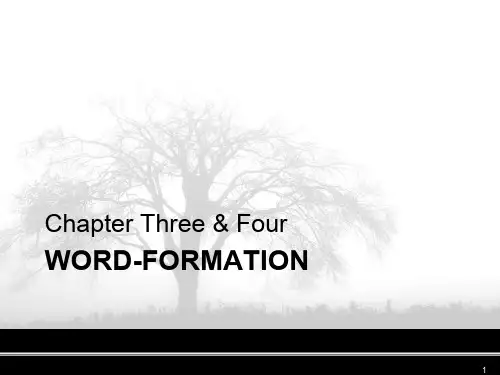
• E.g.: Home + work homework; Pick + pocket pickpocket
– conversion (10.5%) – composition or compounding (27%)
5
• Root, stem, base
– A root is a form that is not further analyzable, either in terms of derivational or inflectional morphology.
3
Inflectional morphology
… suffix in English … in Chinese?
Morphology (word-formation)
compounding
word-formation (derivation)
derivation
affixation: prefix & suffix
Chapter Three & Four
WORD-FORMATION
1
Contents
• An overview • Three major processes
– compounding, derivation and conversinym, clipping, blending, words from proper names, back-formation, reduplication, neo-classical formation and miscellaneous
英语词汇学总结
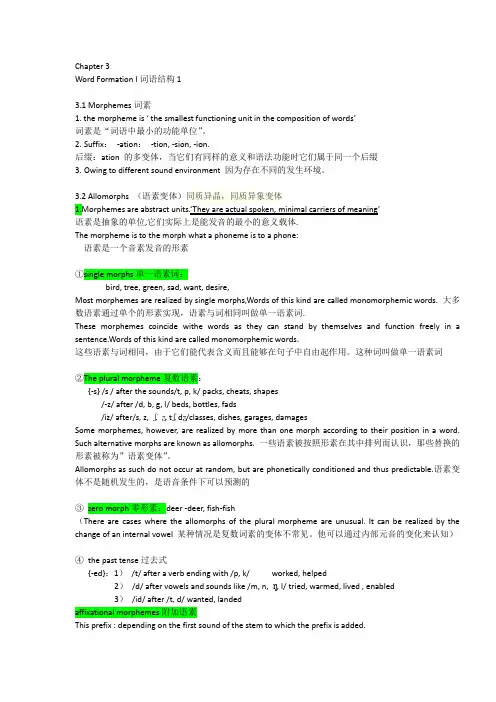
Chapter 3Word Formation I词语结构13.1 Morphemes词素1. the morpheme is ‘ the smallest functioning unit in the composition of words’词素是“词语中最小的功能单位”。
2.Suffix:-ation:-tion, -sion, -ion.后缀:ation 的多变体,当它们有同样的意义和语法功能时它们属于同一个后缀3.Owing to different sound environment 因为存在不同的发生环境。
3.2 Allomorphs (语素变体)同质异晶,同质异象变体1.Morphemes are abstract units.‘They are actual spoken, minimal carriers of meaning’语素是抽象的单位,它们实际上是能发音的最小的意义载体.The morpheme is to the morph what a phoneme is to a phone:语素是一个音素发音的形素①single morphs单一语素词:bird, tree, green, sad, want, desire,Most morphemes are realized by single morphs,Words of this kind are called monomorphemic words.大多数语素通过单个的形素实现,语素与词相同叫做单一语素词.These morphemes coincide withe words as they can stand by themselves and function freely in a sentence.Words of this kind are called monomorphemic words.这些语素与词相同,由于它们能代表含义而且能够在句子中自由起作用。
Word-Formation 词汇学论文构词法-
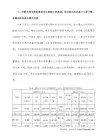
Word-FormationAbstract : A further way besides borrowing in which the vocabulary of English has expanded to accommodate to the natural and social world in which it is used has been to employ means internal to the language itself for devising new word. This is the area of word-formation. Morphological productivity can be defined as the property of a given word formation process to be used to derive a new word in a systematic fashion. Most linguists divide the word-formation into major word-formation and minor word-formation .The major word-formational processes are :-Affixation-Compounding-ConversionThe minor word-formational processes are :-Abbreviation-Back formation-OnomatopoeiaKey Word : affixation, derivative, compounding, abbreviation, onomatopoeia1 AffixationAffixation, also called derivation, is a process in which a free morph is combined with a bound morph, a prefix, or a suffix. It is generally defined as the formation of words by adding derivational affixes to different types of bases . There are two types of derivative . One bases on free root with affix or bound root , the other bases on bound with affix or other bound root .1.1 Types of affixes- prefixes- suffixes- infixesModern English has a number of highly productive affixes. For example, the prefix over can be added to verbs which express activities to indicate that too much has taken place, i.e. something has been overdone, cf. overcook, overcoat, overstay. Likewise, the suffix –n ess can be added to an adjective make a noun designating the quality express by the adjective, its nouniness, so to speak.1.2Two types of derivative’s structure1.2.1 Free root + affix/bound root1) prefix + free roote.g.: In definite (a. uncertain), un forgettable (a. memorable) , mini bus (coach)2)free + suffixe.g. : wealth y (a. rich) , success ful (a, achieving aims) , extreme ly(adv, to a very high de.g.ree) , comfortab ly(adv. in a comfortableway)3)prefix +free root + suffixe.g. : en rich ment (a. sb/sth being rich or richer) , in ternation al (a.connected with two or more countries) , unchangeable (a. that can notbe changed)4)combining form + free roote.g. Afro-American , Afro-Asian , techno-chemistry , microwave1.2.2Bound root + affix/bound root1)prefix + bound root (without formation)e.g. contradict (v. to say sb has said is wrong) , descend (v. go down) ,despair (v. give up all hope)2)bound root (without formation)+ suffixe.g. confidence (n. trust in) , liberate (v. emancipation) , linguist (n. aperson who knows several foreign languages well)3)prefix + bound root (without formation)e.g. distinctive (a. special ) , intolerable (a. can’t bear) , contradiction(n. a lack of agreement between facts)24)combining form + combining forme.g. macrobiosis (n. long life) , microscope (n. an instrument used inscientific study for making very small thing look larger)2CompoundingComposition or compounding is a word-formation process consisting of joining two or more bases to form a new unit, that is, a compound. Compounding is perhaps the most common way of expanding the vocabulary of English. It allows users to combine two familiar words to form a new lexeme.Very often compounds are written as two words, which means that they are accepted into dictionaries a little reluctantly. Certainly, dictionaries seem not to list compounds in anything like the numbers in which they are in use. This may be justified perhaps because compounds are frequently transparent and their meanings are relatively accessible without a dictionary. Furthermore, many of them do not become lexicalized, but have a very transitory life.According to the words’characteristic, there are compound nouns, compound adjectives , compound pronouns , compound verbs , compound adverbs , etc .2.1Compound Nounsn. + n.: bar code , mouse mat , Websitea. + n.: blueprint , compact discadv. + n.: off chance , overdose , underclothes-ing + n.: learning strate.g.y , marketing campaign , parking metern. + v.: daybreak , earthquake , parking meteradv + n : downfall , income , offset , output , upliftv. + adv.: get-together , handout , makeupn. + -ing: air-conditioning , brainstorming , family planningprep.+n.: afternoon , by-product , overcoat2.2Compound AdjectivesAs adjective is a core : airsick , band-new ; dark-blue , icy-cold ;3all-mighty , evergreen , overripeAs noun is a core : blue-collar , present-day ; breaknecl , cross-country ;chicken-hearted , dog-eared , wine-coloredAs –ing or –ed is a core : energy-saving , epoch-marking ; easy-going ,far-reaching ; mass-produced , poverty-stricken ; absent-minded ,half-done , newly-built2.3Compound Verbs1)Formed by back-formation : house-keep from housekeeperwindowshop from window-shoppinghenpeck from henpecked2)Formed by conversion : to blue-printto cold-shoulderto honeymoon3) adv. + v. : cross-questionoffsetoverthrow3ConversionConversion is a word-formation whereby a word of a certain word-class is shifted into a word of another without the addition of an affix. It is also called zero derivation. In other words, conversion or zero derivation is a type word class change without the addition, removal ,or change of any element in the word. In this process a noun maybe used as a verb or a verb can be used as a noun. Furthermore, a noun can be used attributively as an adjective. The most frequent type of conversion is from noun to verb, probably because there are so relatively few verbalizing affixes in English.3.1 n.→ v.1)to put in/on, such as, bottle(n.)→to bottle(=to put …into a bottle)2)to give, to provide with, such as, butter(n.) →to butter(=to spread butteron)3)to deprive of, such as, skin(n.) →to skin(=to remove the skin from)44)to…with, such as, hammer(n.) →to hammer(=to strike with a hammer)5)to be/act as …with respect to, such as, ape(n) →to ape(=to imitate like aape)6)to make/change…into, such as, fool(n.) →to fool(=to make a fool of)7)to send…/go by, such as, bicycle(n.) →to bicycle(=to go by bicycle)3.2adj.→ v.bare(adj.) →to bare, calm(adj.) →to clam, brave(adj.) →to brave3.3v.→ n.Verb converting into noun express the verb’s original action or condition mostly, such as, attempt, look, swim, smile, walk, etc.3.4adj.→ n.Most adjective can be used as noun, such as, an American, an Canadian,etc. There are three type of conversion, full conversion, partial conversionand special conversion.3.5n.→ adj.a brick garage (The garage is brick.)a cotton dress (The dress is cotton.)a gold watch, an iron box, the job market4ShorteningAbbreviation or shortening is the way of shortening or simplifying syllables to make new words. There are various forms of abbreviation, but main forms are four: clipped word, initialism, acronym, blend.4.1 ClippingsSpeakers of English have a great tendency to shorten words. This term refers to the process by which a word of two or more syllables is shortened without a change in its function taking place. It includes apocope, aphaeresis, front and back clipping, and syncope.1) Apocopeapprox.← approximately, auto← automobile52) Aphaeresisburger→ hamburger, bus→ omnibus3) Front and back clippingsThe shortening may occur at the start and the end of the word. e.g., flu(=influenza) / fridge(=refrigerator) / tec(=detective)4) Syncopefluidics← fluidonics, fossilation← fossilizationContractions which is the clipping word with punctuation also can be regarded as this type.4.2 Initialisms and AcronymsInitialisms are words from the initial letters of words which are pronounced as sequences of letters e.g., EEC. Acronyms are also formed from the initial letters of words, but are pronounced as a word, e.g. radar(radio detecting and ranging). Acronyms have always been an integral part of computer culture, and they have since spawned a new language on the Internet. Commonly thought of as a series of letters that make up a “word” there is a distinction between acronyms and shorthand.4.3BlendsBlends are words formed by combining the first element of the first word and the last element of the second word. Blends are created originally for comic effect. Following are some examples:Chunnel(=channel + tunnel) / brunch(=breakfast + lunch) / motel(=motorist+hotel)5Back-formationBack-formation is the process of word-building by which elements are subtracted from a complex word.e.g. beggar---beg burglar---burgleThe majority of backformed words are verbs. There are two types of syntactic relation in verb compounds formed by backformation:1)Object + verb as sightsee (from sight-seeing) meaning somebody sees6sights. Similar examples are: globe-trot(from globe-trotter orglobe-trotting).2)Adverbial + verb, as spring-clean (from spring-cleaning) meaningsomebody cleans in the spring.Back-formations of all kinds are more frequently found in informal than in formal language.6OnomatopoeiaOnomatopoeia is a word-formation which imitate the sound. Imitative words are words formed by imitation of sound. Imitative words divide into primary onomatopoeia and secondary onomatopoeia.The barking of a dog.The crack of a whip.The roll of thunder.The tinkling of bells.There are three types of words formed by imitation of sound:1)The repetition of words: quack; ticktack2)The repetition of words with a vowel change: clitter-clatter; ping-pong;tick-tack.3)Repeating one or more syllables with a consonant change : rub-a-dubt;ran-danReference: Wang Rongpei, Wang Zhijiang, An Advanced Reader of English Lexicology, Shanghai Foreign Language Education Press, 2006汪榕培,王之江,《英语词汇学》,上海外语教育出版社,2008789。
词汇学Word_Formation(2)
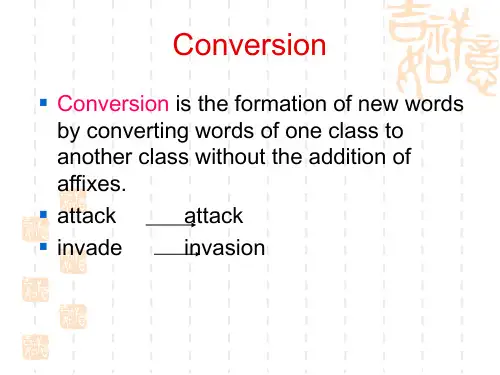
各种各样的“人品”
1、a wise guy 骄傲自大的人。这里的wise并不表示“聪明”, 相反它含有讽刺的意味。Alic’s all right, I guess, but sometimes he’s such a wise guy. 据我看,亚历克这个人还 不赖,不过有时候太狂妄自大了。有时候本词组还用于朋友 之间的调侃。Who’s the wise guy that took my lunch box? 是 哪位机灵的大爷拿走了我的饭盒? 2、a shrinking violet 畏首畏尾的人。原意为“正在发蔫的紫 罗兰”。紫罗兰在背阴的地方悄悄地开花,所以violet是谦虚 的象征,代表“腼腆的人”,但加上shrinking意思就有了变 化。George has a very good mind. He would rise fast in the world if he weren’t such a shrinking violet.乔治很聪明。如果 他不是一个畏首畏尾的人,在社会上早就出人头地了。 3、a backseat driver 不在权限范围内而指手划脚的人。在美 国开车出门是许多人生活的一部分。开车的技术当然每个人 都不一样,一般来说,开车的人都不太愿意被别人指指点点。 所以我们把那些老是喜欢在后面给开车的人提出不必要的指 导和建议的人叫做backseat driver。One place where you find lots of backseat drivers is in politics. 要说指手画脚的人, 在政界你可以找到好多。
A word may undergo multiple conversion:
He was knocked out in the first round. Some drivers round corners too rapidly. The neighbors gathered round our barbecue. The moon was bright and round. People came from all the world round.
现代英语词汇学
现代英语词汇学一、词汇的构成(Word - formation)1. 词根(Root)- 定义:词根是单词的核心部分,它包含着单词的基本意义。
例如,“vis”在“visible”(可见的)、“vision”(视觉)和“visit”(参观)中是词根,其基本意义与“看”有关。
读音:[ruːt],词性:名词。
2. 前缀(Prefix)- 定义:加在词根前面,改变单词的意义。
例如,“un - ”在“unhappy”(不快乐的)中表示否定。
读音:[ˈpriːfɪks],词性:名词。
- 常见前缀及其意义:- “re - ”(再,又),如“rewrite”(重写)。
读音:[riː - ],词性:前缀。
- “pre - ”(在……之前),如“preview”(预习,预演)。
读音:[priː - ],词性:前缀。
3. 后缀(Suffix)- 定义:加在词根后面,改变单词的词性或意义。
例如,“ - er”在“worker”(工人)中表示“做……的人”。
读音:[ˈsʌfɪks],词性:名词。
- 常见后缀及其作用:- “ - ness”(构成名词,表示性质、状态),如“happiness”(幸福)。
读音:[nəs],词性:后缀。
- “ - ful”(构成形容词,表示充满……的),如“helpful”(有帮助的)。
读音:[fʊl],词性:后缀。
二、词性(Parts of Speech)1. 名词(Noun)- 定义:表示人、事物、地点、抽象概念等。
例如,“book”(书)、“city”(城市)、“love”(爱)。
读音:[naʊn],词性:名词。
- 名词的分类:- 可数名词(Countable Noun),如“apple”(苹果),有单复数形式。
- 不可数名词(Uncountable Noun),如“water”(水),一般没有复数形式。
2. 动词(Verb)- 定义:表示动作或状态。
例如,“run”(跑)、“be”(是)。
Word Formation:词汇构成 详解
Word Formation:词汇构成详解Word formation is the process of constructing words from their constituent parts. It involves both the creation and alteration of existing words, which are known as morphological operations. Word formation includes the use of prefixes, suffixes, infixes, compounding, reduplication and more.Prefixes are word elements added to the beginning of a word that modify its meaning. They come from other languages, such as Latin and Greek, and have been adapted into English. Examples of common prefixes include “un-” (not), “dis-” (opposite or reverse), and “re-” (again).Suffixes are word elements added to the end of a word that modify its meaning. Examples of common suffixes in English include "-ing" (present participle), "-ed" (past tense), and "-ize" (to make).Infixes are word elements that are added within a word, usually to modify its meaning. In English, there are few true infixes; most examples are truncated versions of words, such as the informal past tense form "-ed" ("I walk-ed").Compounding is the process of combining two or more words to create a new, single word. Examples of compound words in English include "sunflower," "sunlight," and "sunshine." Reduplication is a type of word formation that involves either repeating part or all of a word. Reduplication can be used to convey emphasis or to add a humorous effect. Examples of reduplication in English include "pitter-patter" and "fancy-shmancy."Blending is another type of word formation in which two words are combined to create a new one. Commonly used blends include "chillax" (chill+relax) and "bromance" (brother+romance).Clipping is a type of word formation in which part of a word is removed. This is done to create a shorter version of the word, often for convenience or to reduce ambiguity. Examples of clipped words used in English include "fridge" (refrigerator) and "fax" (facsimile).Back-formation is a process of word formation in which a “new” word is created by removing a suffix from an existing word. Often the resulting word has a different meaning than the original. Examples of back-formation in English include "edit" (from editor) and "burgle" (from burglar).Conversion is a type of word formation in which a word changes its part of speech without any changes to its spelling or pronunciation. It involves taking a verb or noun and turning it into an adjective or adverb. Examples of conversion in English include "careless" (from "to care"), "homely" (from "home"), and "slowly" (from "slow").Word formation is an important part of language, as it allows us to expand our vocabulary and communicate more effectively. By understanding the various processes involved in word formation, we can communicate more accurately and clearly.。
Chapter 3 Word Formation I
Derivational vs. inflectional morphemes 派生语素与屈折语素
• What are derivational and inflectional morphemes?
Derivational morphemes are used to derive new words when they are added to another morpheme. In English derivatives and compounds are all formed by such morphemes.
3.2 Morph and allomorph
The definition of morphs: The phonetic or orthographic strings or segments which realize morphemes are termed ‘morphs’. 语素的语音或拼写法的体现叫形素。 Morphs are actual spoken, minimal carriers of meaning. 形素是口语中最小的意义载体。
Free vs. bound morphemes 自由语素与粘着语素
Morphemes which are independent of other morphemes are free. Free morphemes have complete meanings in themselves and can be used as free grammatical units in sentences. 自由语素是能独立运用的语素,它有完整的意 义,在句中充当一个自由的语法单位。 E.g., man, wind, open, tour
现代英语词汇学概论3精品PPT课件
词基base是既能添加派生词缀,又可添加屈折词缀 的词素。例如:
i.e:Nationalities
词根 nation 主要意义
词干:nationality 去掉了屈折词缀-ies
词基:nation 是 national的词基 national 是 nationlity的词基
The relative criteria of a compound
1. Orthographic criterion: 书写标准
Compounds are written in three ways, that is, solid, hyphenated and open.
E.g. flowerpot
Chenghu 9.5 Chapter 3 Word-formation (I)
(三种基本构词法)
3.1 General Remark 概述 3.2 Compounding 复合构词法 3.3 Derivation 派生构词法
3.3.1 Prefixation 加前缀 3.3.2 Suffixation 加后缀 3.4 Conversion 词类转换法
Base/ 词基: any form to which affixes of any kind (derivational or inflectional) can be added.
词根、词干和词基
是语言学上一个词删去所有的词缀后剩下的那部分 。
词根root是一个词主要意义的承载部分,是不可以 再分的;
Solid: flowerpot ; moonlight; mooncake
Hyphenated: flower-pot; Mid-A ;
- 1、下载文档前请自行甄别文档内容的完整性,平台不提供额外的编辑、内容补充、找答案等附加服务。
- 2、"仅部分预览"的文档,不可在线预览部分如存在完整性等问题,可反馈申请退款(可完整预览的文档不适用该条件!)。
- 3、如文档侵犯您的权益,请联系客服反馈,我们会尽快为您处理(人工客服工作时间:9:00-18:30)。
Combining forms are distinguished from affixes by their ability to occur as one constituent of a word whose only other constituent is an affix. e.g. autocracy hydrography telephone autocracy = auto [构词成分] + cracy (suffix) hydrography = hydro [构词成分] + graphy (suffix) telephone = tele [构词成分] + phone (suffix) From the point of view of derivation, no distinction should be made between combining forms and affixes in this book, in which all the combining forms are labeled either as prefixes or suffixes.
2) denationalized denationalized = de + nation + al + ize + d Root: nation Stem: denationalize Base: national → nation nationalize → national denationalize → nationalize denationalized → denationalize
The classification of compounding?
Compounds are classified b. Syntactic relation subject and verb 主谓关系 according to parts of verb and adverbial 动宾关 speech of the 系 compounds and verb and adverbial 谓状关 subdivided by the 系 syntactic relation of the compounding element. restrictive relation 限制关 系 a. Parts of speech coordinating relationship 1. n. compounds 并列关系 …… 2. adj. compounds 3. v. compounds
答案:C
风蚀岩石 weather-beaten rocks 日晒的健康肤色 suntanned (skin) 吹毛求疵的人 a fault-finding person 破纪录的速度 a record-breaking speed 免税的 tax-free 无忧无虑的 care-free 防火的 fire-proof 隔音的 sound-proof 滴水不漏的 water-tight 密封的,不漏气的 air-tight
undesirables = un + desire + able + s
Base:
desirable → desire (base) undesirable → desirable (base) undesirables → undesirable (base)
Base/词基: any form to which affixes of any kind can be added.
thunder-struck (houses) houses are struck by thunder / thunder struck the houses well-behaved (person) The person behave himself well. peace loving people people love peace an ocean-going (ship) A ship go across ocean.
The relative criteria of a compound
1. Orthographic criterion: Compounds are written in three ways, that is, solid, hyphenated and open. E.g. flowerpot Solid: flowerpot Hyphenated: flower-pot Open: flower pot
A combining form[构词成分]: a bound morpheme, which was originally a full word in Latin or Greek, but which now occurs only in derivatives. e.g. autobiography hydromechanics television autobiography auto- = autos (Gk) = self self + life + write autoalarm autocracy (auto + alarm) (auto + cracy) (self + to + weapon) (self + ruling ) hydromechanics hydro- = hydòr (Gk) = water hydro-airplane hydrography dehydrate hydrogen television tele- = tele (Gk) = far off telecontrol telephone
3.2 Compounding 复合构词法
Questions: 1. What is compounding? 2. What are the relative criteria of a compound? 3. The classification of compounding?
What is compounding?
Apart from caring for her children, she has to take on such heavy _____ house work as carrying water and firewood. A. time-consumed B. timely-consumed C. time-consuming D. timely-consuming
Compounding / composition: a wordformation process consisting of joining two or more bases to form a new unit. e.g. flowerpot= flower + pot machine-independent = machine + independent back
desirable: desire (root or base, not stem) undesirable: desirable (base, not root, not stem) undesirables: undesirable (stem or base, not root) desired: desire (root, stem or base)
2. Phonological criterion: Compound accent: a main stress on the first element and secondary stress on the second element. Normal phrase accent: a secondary stress on the first element and the main stress on the second element.
E.g.
E.g. flowerpot workday backyard
Note: we can infer the meaning from the meaning of its component parts
red tape (官样文章,烦琐拖沓的公事程 序) dog days (the hottest day of the year) flatfoot (a policeman) blue blood (the quality of being a nobleman by birth) blue ribbon (an honor given to the winner of the first prize) Note: we cannot infer the meaning from the meaning of its component parts back
E.g. black list blackboard blue bottle
3. Semantic criterion: Semantically, compounds can be said to have a meaning which may be related to but cannot always be inferred from the meaning of its component parts.
affixation: a process of forming new words by the addition of a word element, such as a prefix, suffix or combining form, to an already existing word. e.g. recover = re + cover worker = work + er back
